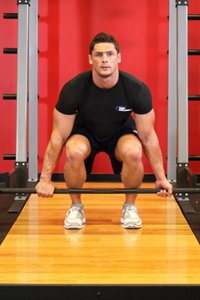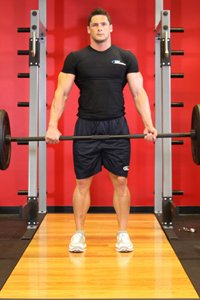The upper back, specifically the Latissimus Dorsi muscle, is a very important muscle due to its size, location and actions. Bodybuilders give compliments to each other by saying "you've got the V-shape".
The upper back is the antagonist of the chest. If your goal is to build massive pectorals, it has to be done in conjunction with the back. It's crucial to train both muscle groups for achieving a good posture and proportion in the upper body.
It's important to learn how the Latissimus Dorsi works in the most efficient way without causing injuries to the muscle and to the surrounding joints, by recognizing its proper actions.
The Latissimus Dorsi actions include moving the humerus (bone of the arm) in adduction to the sides of the body, pulling the humerus in extension from a horizontal position straight out in front of the body and internal rotation of the glenohumeral joint.
How To Determine Your 1RM
Warm up on the bench press using a light weight for 15 slow and controlled repetitions. Then increase the weight by 10% and perform 10 repetitions. Then try to figure out how much weight you can successfully lift for 10 repetitions.
Calculate Your One-Rep Max Here
Load the bar and count the actual repetitions completed. If you predicted to do 80 kg for 10 repetitions and in reality only completed 6, then you would check the following table for percentage that relates to six repetitions.
In the following table, 6 repetitions associate to 85%. Divide the weight lifted (80 kg) by 85% to arrive at the estimated 1 RM. (1 RM = 80/0.85 = 94 kg).
| Repetitions | Percent Of Maximum |
| 1 | 100% |
| 2 | 95% |
| 3 | 92.5% |
| 4 | 90% |
| 5 | 87.5% |
| 6 | 85% |
| 7 | 82.5% |
| 8 | 80% |
| 9 | 77.5% |
| 10 | 75% |
The Workout Program
In order to achieve maximum results, you must obey to the General Adaptation Syndrome (GAS) principle. This training law states that there must be a period of low intensity training or complete rest following periods of high intensity.
The reason for this is that the high stress you have applied to the muscles and joints during the training caused trauma.
A recovery period is required for the muscles to heal and gain strength and mass. If you keep training at high intensity all the time, you may get injured and you will lose muscles instead of gaining lean tissue.
The following program is scientifically designed to achieve your goals of muscle gains while obeying to the GAS principle by cycling the training periods into high, medium and light intensities.
Results may vary between one person and another depending on how their body responds to the imposed stress levels. Some bodybuilders may gain lean tissue in less time than others.
Reading This Workout Log
- Superset: Two exercises are performed consecutively without any rest.
- Drop Set: Also known as strip sets, drop sets involve the immediate reduction of weight between sets with no rest. This will thoroughly burn out a muscle.
- Failure: That point in an exercise at which you have so fully fatigued your working muscles that they can no longer complete an additional repetition of a movement with strict biomechanics.
Program 1: Low Intensity
| Exercise | Weights | Reps | Rest Between Sets |
| Deadlift | 70% of 1RM | 2 sets of 10 reps | 45 seconds |
| Bent-Over Barbell Rows | 70% of 1RM | 2 sets of 10 reps | 45 seconds |
| Lat Pull-down | 70% of 1RM | 2 sets of 10 reps | 45 seconds |
| One-Arm Dumbbell Rows | 70% of 1RM | 2 sets of 10 reps | 45 seconds |
| Seated Cable Rows | 70% of 1RM | 2 sets of 10 reps | 45 seconds |
| Rear-Delt Raises | 70% of 1RM | 2 sets of 10 reps | 45 seconds |
Program 2: High Intensity
| Exercise | Weights | Reps | Rest Between Sets |
| Deadlift | 75% of 1RM | 1 set of 10 reps | 60-90 seconds |
| Deadlift | 85% of 1RM | 1 set of 6 reps | 60-90 seconds |
| Deadlift | 90% of 1RM | 2 sets of 4 reps | 60-90 seconds |
| Deadlift | 80% of 1RM | 1 set of 10 reps | 60-90 seconds |
| Bent-Over Barbell Rows | 80% of 1RM | 2 sets of 8 reps | 60-90 seconds |
| T-Bar Rows | 80% of 1RM | 2 sets of 8 reps | 60-90 seconds |
| One-Arm Dumbbell Rows | 80% of 1RM | 2 sets of 8 reps | 60-90 seconds |
| Lat Pull-down | 70% of 1RM | 2 sets of 12 reps | 60-90 seconds |
| Seated Cable Rows | 70% of 1RM | 2 sets of 12 reps | 60-90 seconds |
Program 3: Medium Intensity
| Exercise | Weights | Reps | Rest Between Sets |
| Superset: | |||
| Lat Pull-down | 75% of 1RM | 3 sets of 8 reps | 60-90 seconds |
| Rear-Delt Raises | 60% of 1RM | 3 sets of 12-15 reps | 60-90 seconds |
| Superset: | |||
| Close-Grip Pull-downs | 75% of 1RM | 3 sets of 8 reps | 60-90 seconds |
| Barbell Pull-overs | 60% of 1RM | 3 sets of 12-15 reps | 60-90 seconds |
| One-Arm Dumbbell Rows | 75% of 1RM | 3 sets of 8 reps | 60-90 seconds |
Program 4: Medium/High Intensity
| Exercise | Weights | Reps | Rest Between Sets |
| Lat Pull-downs | 70% of 1RM | 1 set of 10 reps | 60-90 seconds |
| Pull-ups | 1 set to failure | 60-90 seconds | |
| Rear-Delt Raises | 65% of 1RM | 1 set of 12-15 reps | 60-90 seconds |
| Pull-ups | 1 set to failure | 60-90 seconds | |
| Rear-Delt Raises | 65% of 1RM | 1 set of 12-15 reps | 60-90 seconds |
| Lat Pull-downs | 85% of 1RM | 1 set of 5 reps | 60-90 seconds |
| Drop Set: | |||
| Lat Pull-downs | 85% of 1RM | 1 set of 4 reps | 60-90 seconds |
| Lat Pull-downs | 80% of 1RM | 1 set of 4 reps | 60-90 seconds |
| Lat Pull-downs | 75% of 1RM | 1 set of 4 reps | 60-90 seconds |
| Lat Pull-downs | 70% of 1RM | 1 set of 10-15 reps | 60-90 seconds |
| Lat Pull-downs | 70% of 1RM | 1 set of 10-15 reps | 60-90 seconds |
| Lat Pull-downs | 75% of 1RM | 1 set of 10-15 reps | 60-90 seconds |
| Seated Cable Rows | 70% of 1RM | 2 sets of 10 reps | 60-90 seconds |
| One-Arm Dumbbell Rows | 70% of 1RM | 2 sets of 10 reps | 60-90 seconds |
Program Schedules
Week 1
- Monday: Program 1
- Thursday: Program 1
Week 2
- Tuesday: Program 2
Week 3
- Monday: Program 3
- Friday: Program 4
Notes:
- Execute 5-10 minutes warm-up before every training session.
- Stretch the back muscles after each training session.
- Wear a belt when using heavy weight in the deadlift.
- Train the antagonist muscle group (Chest: Pectoralis Major), to maintain good muscle proportion and proper posture.
The Proper Way To Perform The Deadlift
Bend over and hold the barbell 10 cm wider than shoulder width, palms facing your body (or you can place your hands with the palms opposite to each other). Keep your head up, your sight straight forward, your chest lifted, your shoulders retracted, maintain your back flat but not hyperextended, and keep attention to the alignment of your head, neck, scapula, pelvis and hips.
Balance the weight of your body on both feet while feeling the engagement of your gluteus and thighs. Pull the weight up until you reach a standing position. Don't hyperextend at the end of the movement. Never hold your breath. Exhale on the upward phase and inhale on the downward phase of the movement.




